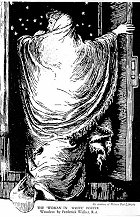Poster development in the UK was very similar to other
major countries around the world. Lithography was invented in 1798 , but was
an expensive process and only used for major commercial advertising.
 BUT
the UK holds another SPECIAL connection to 'the poster'. In 1860, Wilkie Collins,
a very popular writer in the UK and friend of Charles Dickens, wrote the novel
'The Woman in White' which became a top seller. A few years later, at a dinner
party at Collins house in Thurloe Place, Frederick "Fred" Walker,
a well known illustrator and friend of Collins, did a sketch of The Woman
in White. Collins loved it. In 1871, when an adaptation of the novel was released
on stage as a play, Walker was commissioned by Collins to create the sketch
as a poster to advertise the play(shown on the left). This was the first time
that a well-known artist had been commissioned to design a theatre poster.
BUT
the UK holds another SPECIAL connection to 'the poster'. In 1860, Wilkie Collins,
a very popular writer in the UK and friend of Charles Dickens, wrote the novel
'The Woman in White' which became a top seller. A few years later, at a dinner
party at Collins house in Thurloe Place, Frederick "Fred" Walker,
a well known illustrator and friend of Collins, did a sketch of The Woman
in White. Collins loved it. In 1871, when an adaptation of the novel was released
on stage as a play, Walker was commissioned by Collins to create the sketch
as a poster to advertise the play(shown on the left). This was the first time
that a well-known artist had been commissioned to design a theatre poster.

By the 1880s and 1890s, the primary type of advertising
for opera houses, vaudeville, music halls (called family theaters) and circuses
was the long bill (shown on the right). It was a very simple posting of different
acts that were scheduled to perform with a short description of the act itself.
The one shown on the right is from 1886 in London.
 This
format was used for decades as a standard for the entertainment industry.
Shown on the left is a poster from the Fred Karno Repertoire Company from
1910 when he brought Charlie Chaplin to the United States. As an FYI, Fred
Karno was a British pioneering showman, who discovered Charlie Chaplin and
Stan Laurel, assembled The Crazy Gang, and invented a style of shambolic
comedy that survives today in the knockabout comedy routines of every British
Christmas panto.
This
format was used for decades as a standard for the entertainment industry.
Shown on the left is a poster from the Fred Karno Repertoire Company from
1910 when he brought Charlie Chaplin to the United States. As an FYI, Fred
Karno was a British pioneering showman, who discovered Charlie Chaplin and
Stan Laurel, assembled The Crazy Gang, and invented a style of shambolic
comedy that survives today in the knockabout comedy routines of every British
Christmas panto.
In the late 1890s, London was the largest city in the
world (the 1900 census has London population at 6,480,000, with the second
largest city in the world listed as New York at 4,242,000). With this distinction
came the desire to be a center of the entertainment world as well. In 1894,
London had its first poster show with the newest Art Nouveau poster craze
created by Alphonse Mucha in Paris that same year.
With this poster craze came a wide variety of posters
that were in almost every size imaginable on the larger performers.
As the film industry was beginning in the late 1890s,
the advertising started as a listing on the long bill as a novelty and put
between acts to give the stage performers a chance to set up. But within a
few years films rapidly moved to dedicated facilities.
The posters moved from highlighting the novelty, to
focusing on the equipment (new fire retardant equipment became major issue
after several fires threatened the entire industry). Next the posters began
focusing on the production companies until Charles
Hepworth introduced the star system.
Poster sizes began to stabilize around 1910 with poster
sizes used by the studios being dictated by the paper industry. By 1913 Westminister
records show 2 companies: Cinema Poster Exchange at 3 Archer Street and International
Printing Co. - 7 Bear Street - Charing Cross Road providing posters for the
industry.
Unfortunately, due to recycling of paper during WWI
because of paper shortages and then again in World War II, documenting the
origins of each size is extremely difficult. Unlike the United States, the
British film industry seemed to adopt a very simple and common system for
poster size development.
The film industry was in the middle of making changes
from the Moyne Report which was a committee to study the effects of the quotas
set in 1927. (See Cinema Regulations).
In addition, in what I would consider a very unusual
coincidence, in 1934, the Advertising Association was under fire as being
a waste of money. They formed their inhouse Publicity Department and started
a campaign to "teach the consumer... the immense value of advertising".
From 1936-1939 the focus from the Advertising Association
was to make the British public aware of British products and create a pride
in British products that were advertised. The full campaign was cut short
due to the beginning of the war.......
HOWEVER..... it is VERY ODD that both the Moyne Report
for change AND the Advertising Association advocating change were about the
same time that the NEW Broadside British Quad appeared. So far I have not
been able to substantiate the actual first posters issued or studio which
issued them YET.
The beginning of the war in 1939 immediately created
paper shortages and a completely different set of priorities on advertising
and the film industry.... a lot of which will never be able to be fully documented.
Also notice that the size 27x40, 3 Sheet and 6 Sheet
are MISSING from the chart. We will try to establish the origin of this size
in the individual articles.
We have an article on individual sizes with more information.
See our articles on Bus Stop, Crown,
Door Panels, Double
Crown, Front
of House Cards, Half
Sheet, Lobby Cards, Mini
Quad, One Sheet, Presskits, Quad,
Six
Sheet, and Three Sheet



